Ennio Morricone
Iconic Italian film composer Ennio Morricone passed away on July 7 at the age of 91. Active as a musician and composer from the late-1940s (!) all the way up to his death, Morricone ranks among the most acclaimed artists in the medium of film music. However, it’s safe to say, as the iconoclastic New York composer John Zorn asserted in his New York Times obituary/tribute, that the influence of Morricone's work moved far beyond the paradigm of film scoring and that he should rightly be considered one of the greatest composers of the 20th century, full stop.
Though he first came to widespread recognition outside of Europe for his music that soundtracked Sergio Leone’s western classics such as The Good, The Bad, & the Ugly and Once Upon a Time in the West, Morricone famously balked at being pigeonholed as a Western-movie composer. He argued that westerns occupy only 8 percent of his filmography, which stretches past 400 scores for everything from gritty crime dramas, to sentimental family fare to twisted and experimental art-house movies. While the films that Morricone’s music scored were undoubtably enhanced by his musical genius, his work can be just as easily be enjoyed on its own, outside of the context of a full cinematic viewing.
Though he was a master of crafting affecting, memorable melodies and main themes that instantly resonated with listeners and moviegoers, some of Morricone’s greatest strengths existed in his experimental approach to instrumental arrangements, his penchant for adventurously colliding disparate genres, and his fine-tuned ear for the little details in production that appeared in virtually all of his scores. Here, we’ll take a look at 10 key tracks from the maestro’s oeuvre. Though his Western soundtracks feature into this list, they’re only the first touchstone in a vast and diverse catalog of masterpieces.
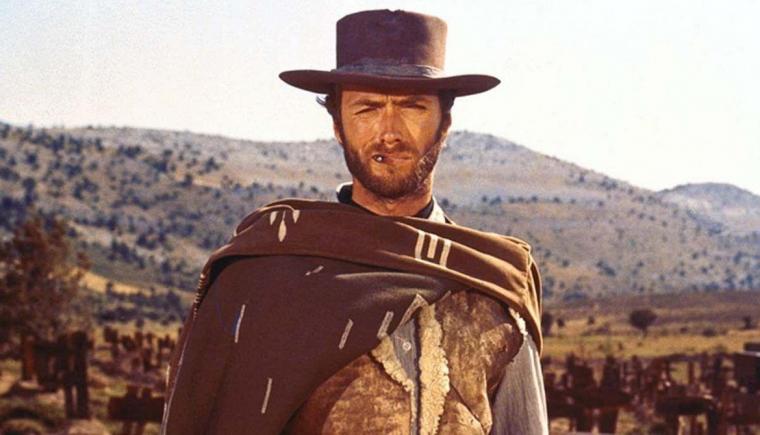
1) “The Ecstasy of Gold” from The Good, The Bad, & the Ugly (1966)
https://www.youtube.com/watch?v=PYI09PMNazw
Although the iconic “AWWW-EE-AWW-EE-AWWWWWW – WAHH, WAHHHHH, WAHHHHH” main theme from The Good, The Bad, & The Ugly gets the lion’s share of recognition from everyday listeners, having been folded into an infinite number of parodies, memes, and tributes over the decades, the rest of the soundtrack deserves just as much love. “The Ecstasy of Gold” captures the high tension and epic drama of Sergio Leone’s movie with its galloping rhythms and high-flying vocal leads, but like the film itself, the song moves through a suite of contrasting emotions and levels of intensity. Morricone was often credited with introducing the guitar, both in its acoustic and electric incarnations, into the wider lexicon of film scores that were previously almost exclusively dominated by orchestral instrumentation in the classical tradition. “The Ecstasy of Gold” makes the most of an uneasy chord progression played on the acoustic guitar, which lays out the harmonic groundwork for a slew of more orchestral voices – swelling strings, that yearning clarinet, and rollicking drums – to interact with. By the time the track has burgeoned to its huge climax, layered thick with wailing vocal lines and blaring trumpets (Morricone’s primary instrument as a player, himself), listeners’ hearts are already racing in time with the rapid edits, eye to eye, of the film’s duelists.
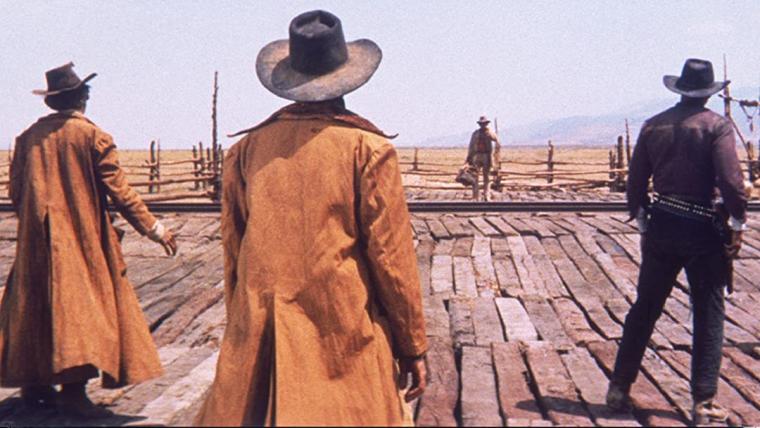
2) “The Man With the Harmonica” from Once Upon a Time in the West (1968)
https://www.youtube.com/watch?v=m6BQKFs3-VM
Another instantly recognizable Morricone theme from his Western canon, “The Man with the Harmonica” generates a fever pitch of tension with its heavily smeared, reverbed harmonica lines, moaning out into the void of the desert. For those who have seen the movie, the image of the harmonica itself and its role within the climatic battle scenes, handled by Charles Bronson’s character known as, well, “Harmonica,” is seared into your brain. The track’s true heart, though, lies in its towering electric guitar performance – which comes to represent the opposition to the harmonica’s more chaotic neutral presence. Though some string voices swirl through the mix with the two lead instruments, heightening the drama between them, it’s truly a showdown between the moans of the harmonica and the bone-dry, chimed notes of the guitar that crash through the stereo spread. At this point, when we imagine a Western movie, the electric guitar seems like an obvious association. What better way to convey the lone gunman stalking his quarry out in the dusty plains than a bad-ass guitar riff? Of course, we owe that association directly to Ennio Morricone. A couple steps removed from country twang, Morricone’s guitar here has a more frightening, almost nihilistic undercurrent as its searing notes rip through the track in bouts of pure drama and dead-eyed brutality. The guitar traces a simple melody, less than a dozen notes or so, but each of those notes hangs in the air menacingly over the desert.
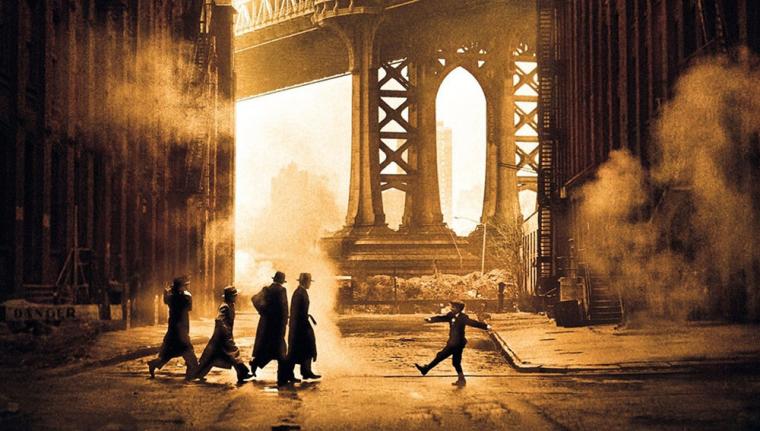
3) “Poverty” from Once Upon a Time in America (1984)
https://www.youtube.com/watch?v=iHPGD2aDzvU
By the time Sergio Leone made Once Upon a Time in America, the trope of the mafioso had taken over Hollywood thanks to Francis Ford Coppola’s The Godfather series. Leone famously turned down the chance to direct The Godfather to see his own passion projects through to their end, principally a loose trilogy of films that began with Once Upon a Time in the West, continued through Duck, You Sucker!, and concluded with Once Upon a Time in America. The third film in this trilogy fits right into the lineage of American mafia epics, and its score by Morricone pushes the needle away from the sonic vocabulary of the Western and closer to the majestic melodrama of the Italian-American crime saga. “Poverty” is an extreme heartstring-tugger with its slowly roiling atmosphere that builds from a lead piano melody played purposefully ever-so-slightly out of key. But if Morricone knew how to tug those heartstrings even with the very first opening salvo of the song, the way that it evolves through lovely harp accents and a lonely piccolo melody makes sure that there are no dry eyes left in the building. As if to twist the emotional knife even deeper in, Morricone drops an enormous orchestral string climax around the two-minute mark, like “Don't forget – this is high drama, people!” But in classic fashion, he follows it up with a solitary guitar playing the same melody into the haze, coloring in the sentimental landscape with different shades of the same central mood.
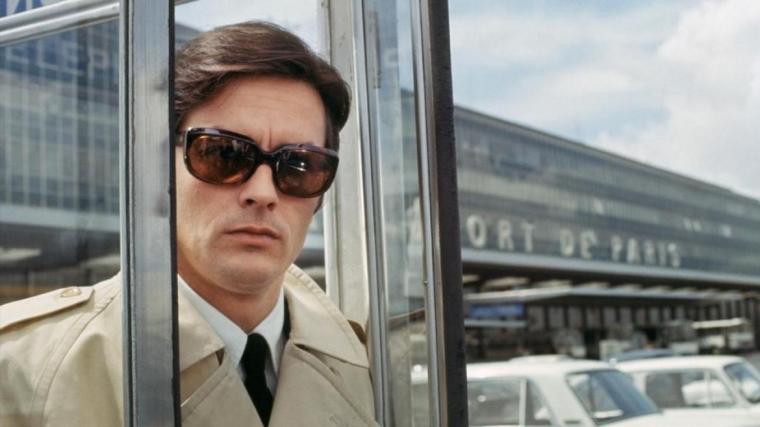
4) “The Sicilian Clan” from The Sicilian Clan (1969)
https://www.youtube.com/watch?v=GwmdscZNTQU
In an ocean of contenders, “The Sicilian Clan” gets my vote for the best Morricone theme, pound for pound. Like “Poverty” above, the theme plays with the tropes of the Italian mobster movie that would come to a head with Nino Rota’s Godfather score in 1972, but Morricone approaches this genre from an oblique angle. The way that he deftly mixes different emotions and moods within the context of one track, conveyed in the contrasting harmonic palettes and overlapping major-key/minor-key phrases is nothing short of stunning. There’s Morricone’s classic brittle electric guitar at the center of the song, tracing out the primary progression that moves deliberately from chord to chord, changing only one note at a time. The progression is a master class in re-harmonization and emotional tempering, as each chord gets slightly more dissonant or more consonant when one note changes, leading listeners down a twisting path of peaks and troughs of sentiment. Of course, the rest of Morricone’s arrangement here pulls its own weight, with the lovely, swooning strings and piano draped behind the guitar, and the gently pulsing bass and drum tracks that carry it all ahead on an improbably bouncy rhythm. Morricone lets the progression loop again and again, while the backdrop complicates and the production thickens with new voices. Amazingly, the track can be boiled down to one four-note phrase that recurs throughout – a totally chromatic phrase, moving down half-step to half-step (meaning, four individual notes next to each other on the piano; the nearest possible neighbors that can constitute a melody).
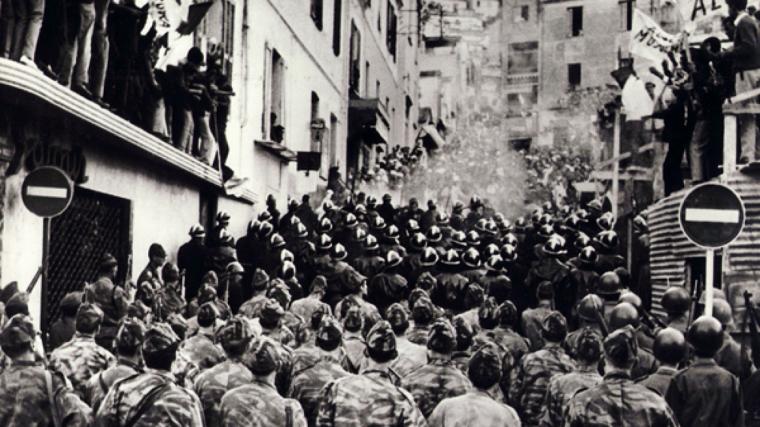
5) “The Battle of Algiers” from The Battle of Algiers (1966)
https://www.youtube.com/watch?v=dWJTFMPybYw
Though clocking in at under two minutes, Morricone crams so much drama into the main theme for The Battle for Algiers. One could call this one of the more “prog” themes in his oeuvre with its constantly shifting rhythms and the stuttering piano line that loops irregularly across different meters, all while a martial snare drum pounds out the main beat that animates the entire track. The gradual upward motion in the narrative here is perfect, as Morricone moves from playful, teasing horn melodies into more chaotic brass blasts, into a climax of wailing strings that shatters the mood. The song perfectly matches its context in the movie, which tells the story of the guerrilla rebel fighters battling the French government in Algeria in the mid-20th century. The uphill battle, with all of its tenuous power struggles and uncertainties, comes out in Morricone’s twitchy theme – all bluster and confusion, but still girded by martial certainty and regimented rhythm.
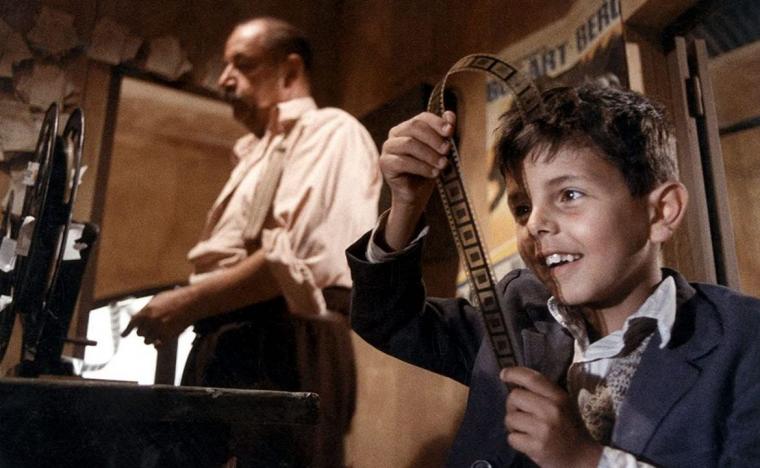
6) “Love Theme” from Cinema Paradiso (1988)
https://www.youtube.com/watch?v=VclRS7x0e38
Mmmmmmm. Yes. One of the pinnacles of Morricone’s weepy, borderline saccharine film compositions, the “Love Theme” from the beautiful Cinema Paradiso has become a standard in itself for absolute schmaltzy beauty. Contextualized in the movie’s plot about an Italian family that own a movie theater and maintain it through major historical and familial upheavals, Morricone’s score serves as a love letter to the art of cinema itself – a moment of blind sincerity in a career characterized more often by the composer’s biting wit and irascible temperament than for any semblance of personal sentimentality. Sure, Morricone’s scores are hugely sentimental by definition, but it always feels like a puppet master pulling the strings from somewhere up above us, looking down and saying “that’s right, you better cry at this part” – knowing full well, as the master he is, that his instructions must be obeyed. But then we have “Love Theme.” Here, Morricone seems to be reveling in the sheer cheese of it all, no longer only guiding our emotions but getting swept up himself. There are no harsh contrasts here, no tricky arrangements that subtly incorporate dark details or weird instrumentation into the background. This is six minutes of absolute beauty, animated by descending piano cadences and major-key string chords. The progression tumbles up and down the scale and settles into soft lulls before leaping back into action. Solitary oboe melodies melt into the ether. The tempo picks up ever so slightly at the three-quarter mark, as if to get our hearts beating faster. When the full weight of the strings slams down for the finale, it feels like a TKO to our hearts.
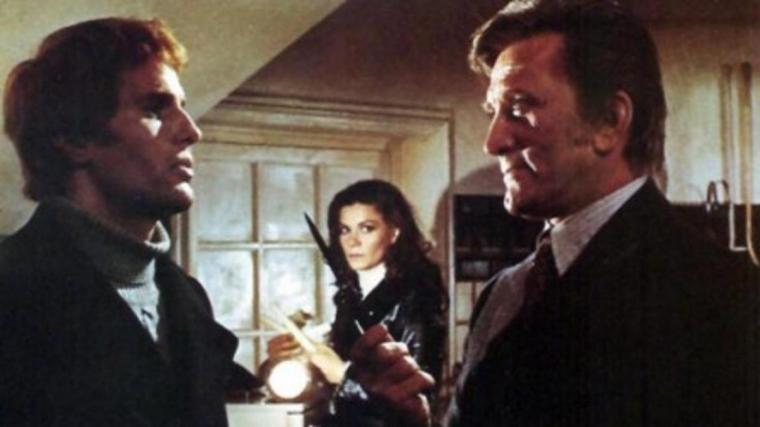
7) “Un Uomo da Rispettare” from The Master Touch (1972)
https://www.youtube.com/watch?v=XRmuHFCGgfo
Morricone throws out all the stops for this one, an 11-minute suite-like piece of continuously changing atmosphere and brooding melodrama that segues through so many discrete emotions that it seems to contain an entire movie unto itself. Encompassing stark, dissonant horn soundscapes, a passage of what could be called slow-burning psych-rock, a towering trumpet solo that wouldn’t be out of place in a fusion era Miles Davis album, and a bombastic orchestral string arrangement, the track generates a large part of its power from the empty space between the peaks. To describe each section of this piece is to miss the point – the goal here is to let Morricone’s evolving vision carry you along, with all its unexpected detours, to somewhere far from where you began.
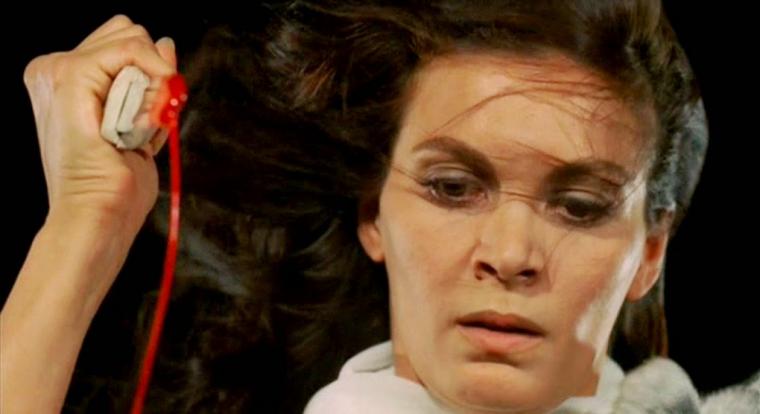
8) “Giorno Di Notte” from Una Lucertola con la Pelle di Donna (1971)
https://www.youtube.com/watch?v=XggY_DqSDrE
Speaking of psychedelic rock, Morricone made plenty of that too. Like, without even conceding to the institution of “classical” orchestral music in the least. This is a psych rock band noodling their hearts out. Two electric guitars wiggle around through the corners of the mix, fried with distortion, but still nice and tinny, like they’re reaching us through a tiny speaker hidden in the corner of a practice space. Multiple overdubbed electric pianos also swirl through the mix, clattering out dissonant figures and descending into straight up noise. But then, at the center of it all, you have that nice chubby bass, like something right out of a pulpy porno soundtrack, just bouncing away. The movie, Una Lucertola con la Pelle di Donna, translates to A Lizard in a Woman’s Skin – a classic giallo horror flick directed by the master of the genre, Lucio Fulci, replete with psychosexual madness, orgies, and LSD. By the time Morricone’s “Giorno Di Notte” finishes off with those squiggling synth voices that sound like a boat engine overheating, you might wonder if you’ve been dosed yourself.
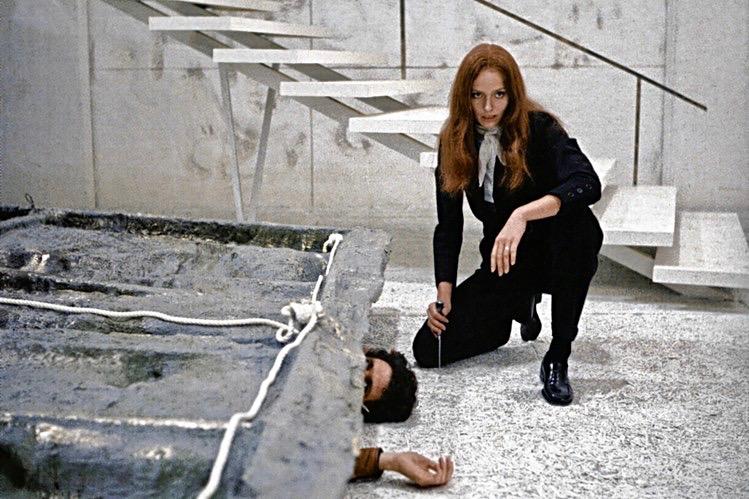
9) “The Bird with the Crystal Plumage” from The Bird with the Crystal Plumage (1970)
https://www.youtube.com/watch?v=lImwGri5S5w
Another giallo horror classic, this one directed by Dario Argento, The Bird with the Crystal Plumage gets the Morricone treatment with this unexpectedly sweet, straightforward theme song that only hints at the terrors waiting below. It’s a perfect move, kicking off a psychological murder mystery with a little sing-song ditty that willfully channels the simplicity and bright-eyed optimism of a children’s song. While the constant “la la la” refrains falls right in line with Krzysztof Komeda’s score for Rosemary’s Baby, Morricone also deviates from the cradle-friendly lullaby template when his theme breaks open into a mid-tempo folk-rock strut, allowing the atmosphere to complicate a bit with more somber harmonies – though still held down by twinkling music box melodies. One imagines moviegoers in Italy in 1970 had no idea what they were getting into with this one. “Are we in the right theater?” Regardless of the bait and switch, Morricone lets his raw talents for affecting melody writing shine here, stripping the music down to empty vocalizations but still absolutely transfixing us.
![]()
10) Gruppo Di Improvvisazione Nuova Consonanza, Musica Su Schemi (1976)
https://www.youtube.com/watch?v=sN2pG29qYaw
In addition to the near-constant stream of film scores that poured out of Morricone during the '60s, '70s, and far beyond, his “solo” career in this regard wasn’t his only musical project. The Gruppo Di Improvvisazione Nuova Consonanza formed in Rome with Morricone, Franco Evangelisti, Frederic Rzewski, Egisto Macchi, and more – a large rotating cast of musicians who were primarily known as film composers, but who all played instruments themselves, and were widely versed in experimental sound art and musique concrète. The group’s collage-like, extended sessions focus on acoustic instruments like horns, pianos, and strings, but apply them in a way closer to the hallucinatory orchestral works of Edgard Varèse or Karlheinz Stockhausen, focused on atypical extended techniques, textural scrapes, percussive blasts, and straight up noise jamming. Morricone played trumpet and flute primarily in their sessions, and he blows on his instruments like a madman, wailing out atonal anti-melodies or dipping down into low, guttural rumblings. Their 40-minute album Musica Su Schemi from 1976 is the perfect starting point for the Gruppo. Pop on this little number and let the experimental Italian freaks whisk your mind away to parts unknown.








